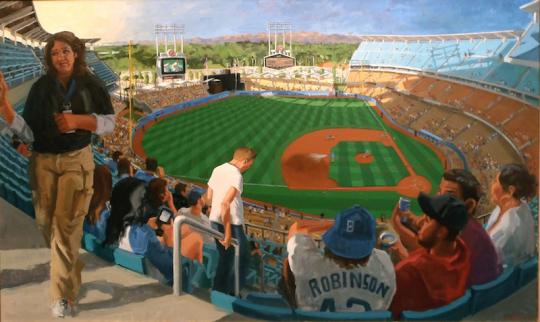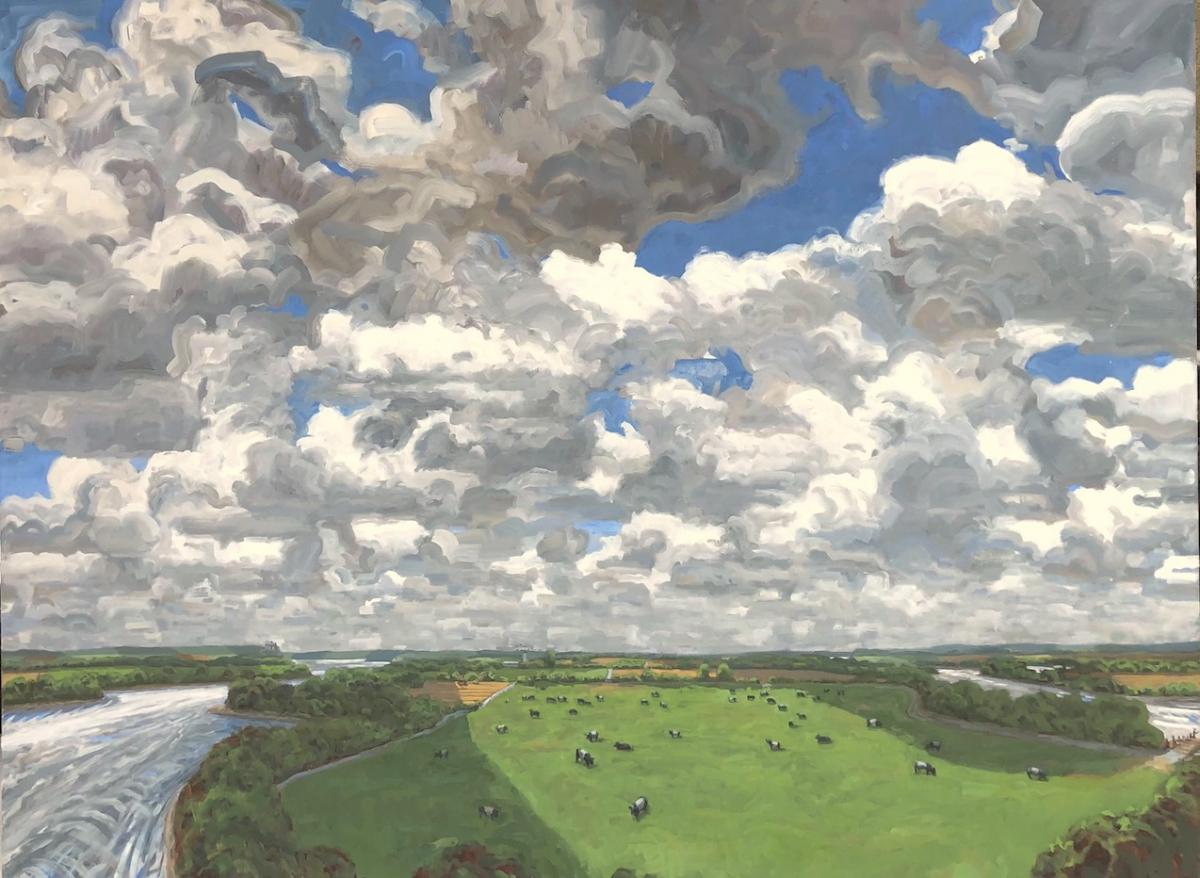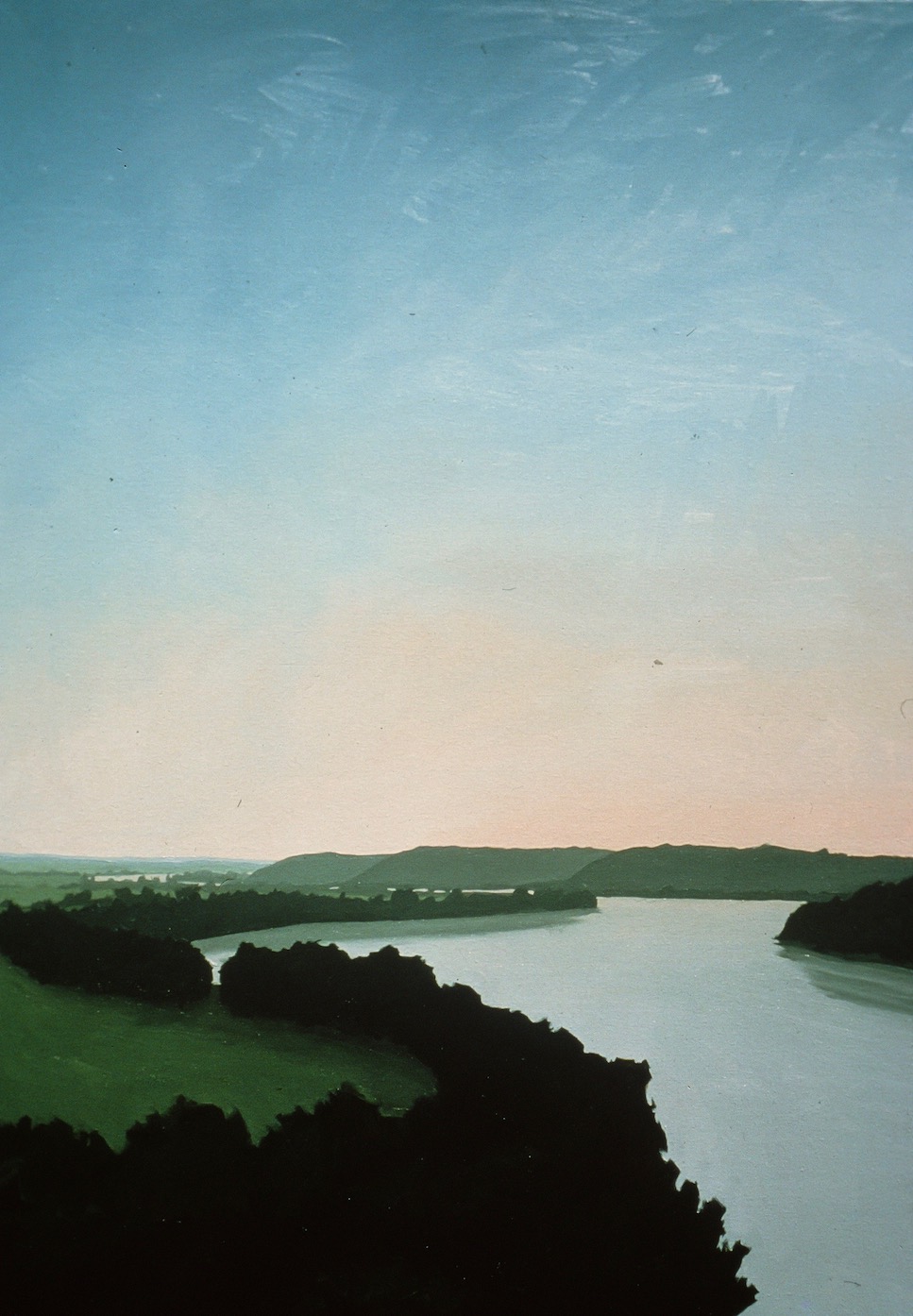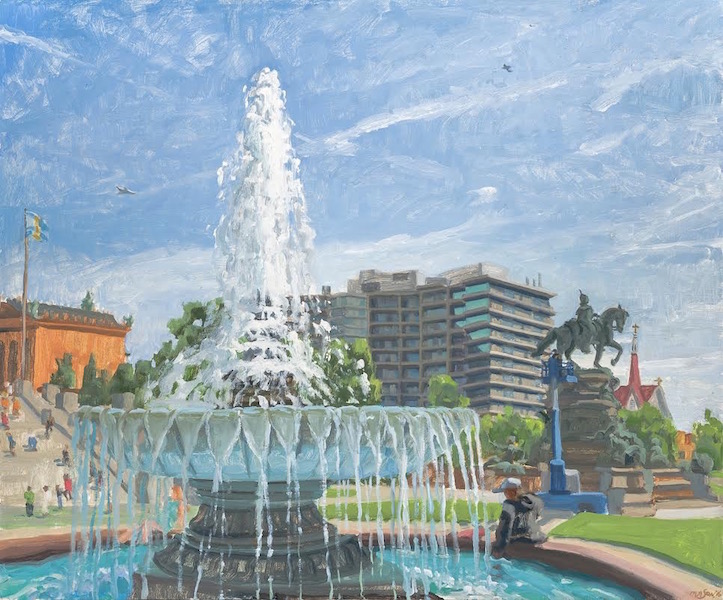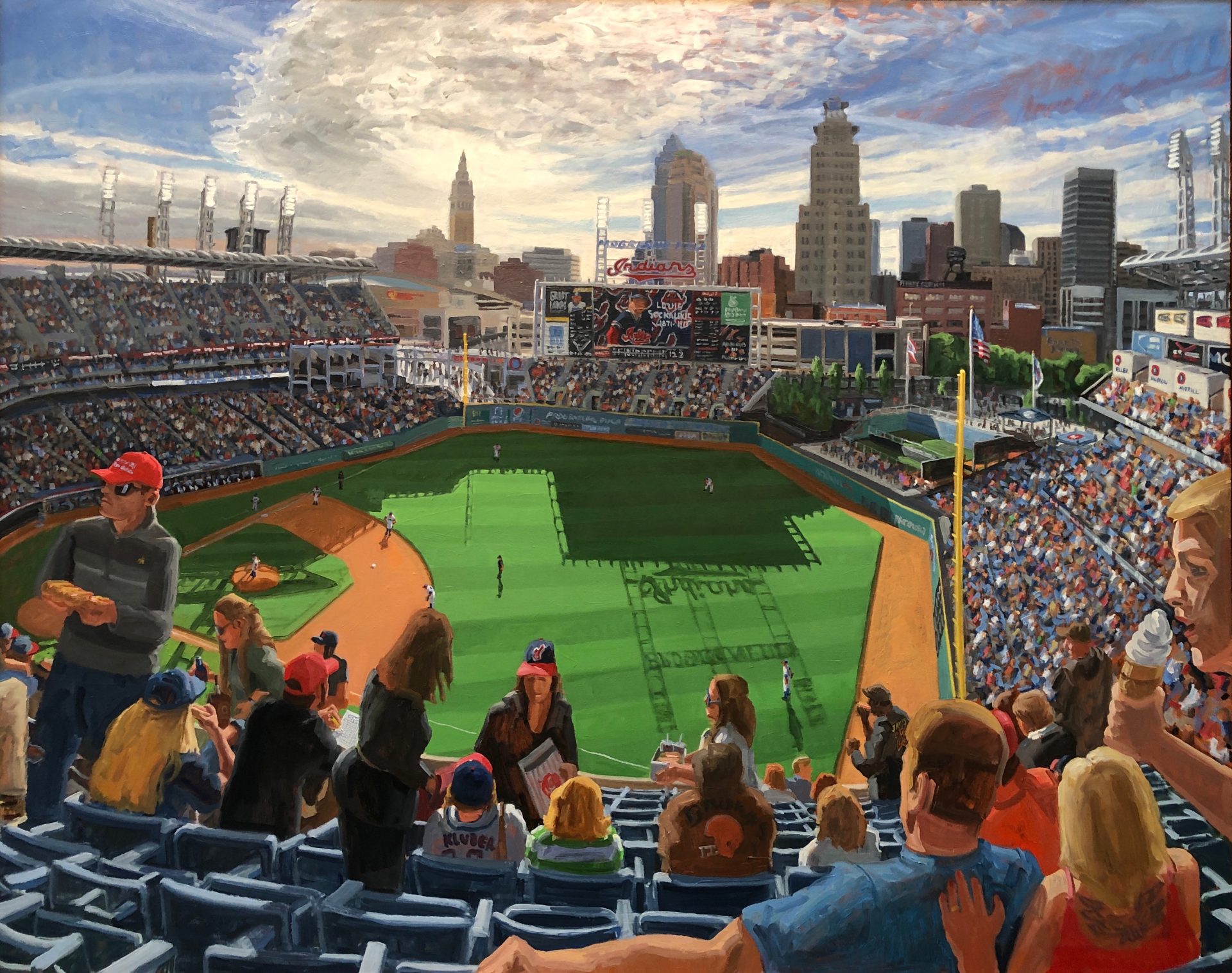Carved into the hillside of what was once an old Hispanic neighborhood, Dodger Stadium sits a scant quarter mile from the glass towers of downtown LA. Because of geography and orientation there is virtually no awareness of the city from the Stadium. It faces the Santa Monica Mountains with snow capped Mt. San Jaquinto in the far distance. Until recently the smog was so bad you could barely see the mountains. California’s strict automobile emission laws have done what few thought possible, brought the mountains into view once again. The classic modern design is a purist’s delight, reminiscent of the homes and swimming pools that dot the Hollywood Hills. There is virtually no vertical expression of the building as one walks up from the vast surrounding parking lots and enters at the very top. The fertile bowl of southern California opens up in front of you as one goes through the turnstiles. It is as if one is entering an arcadia, the Los Angeles of past dreams. But the dream turns darker the more one learns about it’s history.
Before Dodger Stadium Chavez Ravine was a hilly geographic oddity of soft, clayey rock, hard to build on, and home to over 300 mostly Hispanic families. It was healthy and vibrant but poor. It was also just up the hill from downtown and city hall.
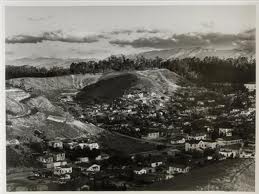
With funds from the federal housing act of 1949 neighborhoods were being razed all over the country in the interest of eliminating poverty and “cleaning up” a decaying, unfashionable architectural past. A plan pioneered by the idealistic public housing advocate Frank Wilkinson was put forth to make Los Angeles the first city devoid of “slums”. He hired the famous modern architect Richard Neutra to design a public housing project for Chavez Ravine. Instead of ramshackle, “unsightly” wooden homes surrounded by children playing in the dirt and chickens running free, the residents and homeowners would be re-housed in beautiful, tastefully landscaped modern apartments with plenty of free parking. Yes, those were the optimistic, naïve, condescending, not to mention racist, ideas of the time, reenacted in virtually every American city. First relocate the locals, bulldoze the buildings, then construct an “urban utopia”, complete with sidewalks and garages. What could be nicer or more American.

The initial buying out of Chavez Ravine was at fair market value, which of course wasn’t much compared to rest of LA. Then there was intimidation, physiological and ultimately physical. Prices fell further as folks panicked until there was a full scale bail out.

Everything was going along as planned until Frank and his utopian ideal came afoul of McCarthyism. There were hearings accusing him of being motivated by a Communist agenda. In the stated view of certain politicians all this “utopianism” was a plot to undermine freedom and ultimately take over the country. It’s pretty clear now this was simply a ruse by these same politicians to encourage certain, behind the scenes, “exchanges of cash” to make the hearings go away. Wilkenson and Neutra didn’t have the money or backing so the hearings went on and the city fathers were left with an increasingly vacant 356 acre parcel of land right next to downtown. Enter Brooklyn Dodgers owner Walter O’Malley.
O’Malley had been struggling with the City of New York to acquire land to build a new ballpark in Brooklyn. People were moving out to the suburbs of Long Island, commuting by car, and not taking public transportation to Dodger games. He could see his beloved, old, in need of major repair and parking challenged Ebbetts Field wasn’t in the future of the Dodgers. O’Malley had a plan for a new ball park in Brooklyn, a Buckminster Fuller designed dome no less, that fit his needs. Unfortunately for fans of “Dem Bums”, as Brooklyn fans were frequently dubbed, New York City Commissioner and power broker Robert Moses could not be persuaded to work out a deal for the land. What Moses didn’t know was that O’Malley had been courted by Los Angeles politicians, who had a certain 356 acre parcel of FREE available land, with HUNDREDS of acres of parking (not free for future fans) right near downtown. O’Malley would have preferred at this point to stay in New York. Los Angeles made no financial sense if he was the only team on the west coast. The distances were just too far. But he also knew New York Giants owner Horace Stoneham was looking to move to Minneapolis. O’Malley was able to arrange a meeting with Stoneham and San Francisco mayor George Christopher. All the pieces fit together and the deals were done. Although O’Malley is often seen as the bad guy who broke the hearts of Brooklynites, Robert Moses is more to blame. O’Malley even went back to him after making his plans and gave him a last chance to change his mind, but Moses stood firm. The Dodgers and Giants moved in 1958 and Major League Baseball came to the west coast.

Ironically, the principle designer of Dodger Stadium, Emile Praeger, is best known for his work in New York for Robert Moses. During the four years it took to complete Dodger Stadium, the Dodgers played in the palatial, but not well suited for baseball, Los Angeles Coliseum. They won the 1959 World Series and set attendance records in the process. Even before Dodger Stadium was completed in 1962 the Dodgers move west was a spectacular success. The beauty of the completed stadium only added to the increasing evidence that O’Malley made the right move.
Going to the Game
It was just another gorgeous southern California evening as I sat in my usual place, in the back of the upper deck at Dodger Stadium. The Dodgers were playing the San Francisco Giants, winners of the last years World Series. Unexpected was the palpable tension between the locals and the cocky Giants fans, wearing their World Series victory gear. The day before, on opening day, a Giants fan was beaten unconscious by a group of Dodger fans who didn’t like his “high and mighty” attitude. One assumes alcohol was involved. The fan suffered permanent brain damage as a result of the beating. While the light and weather was perfect, the spirit in the balmy air was mean. But my job was to look and absorb.
That “ahhhh” moment of coming out of the crowd and endless parking lots to look out on the Southern California landscape at Chavez Ravine is unsurpassed. I immediately started sketching and taking as many pictures as I could before the stands filled up, the light changed and it was hard to move around. I couldn’t help thinking of the old neighborhood as groups of Hispanic young men and women came in and sat down on either side of me. The game began as the light slanted across the parking lots, foothills, and Santa Monica Mountains in the distance. While the sky turned indigo the stadium lights came on and then took over. By the 6th inning and I was ready for a quick Dodger Dog and a Bud before I snuck out early, joining a few Dodger fans who didn’t want to get stuck in traffic. Dodger fans are notorious for their early exits, and for good reason. Plenty of available parking just doesn’t cohabitate well with limited egress and the urban fabric that surrounds Chavez Ravine on all sides. Even though I didn’t park in one of the massive parking lots that cradle the Stadium like gigantic flower petals, it took a while to get to my car in what is left of the old neighborhood. (There still are a couple streets overlooking the ballpark that harken back) As I got in my car I heard the unmistakable crow of a rooster.
Painting the Painting
My first idea was to use the big fellow that sat in front of me to set off the rest of the Stadium and landscape below. The fact that he was jauntily wearing a Brooklyn Dodgers hat was perfect.

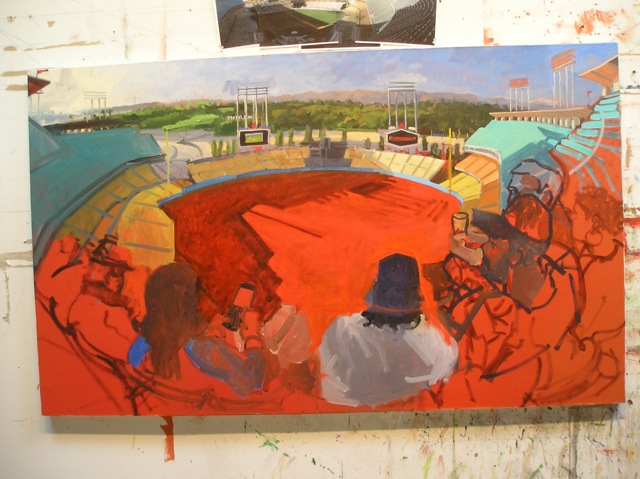
As I continued to work it seemed nutty to be blocking that amazing landscape with a big white back. He needed to become more integrated into the composition. A couple things stood out as I looked over my photos of the fans. A group of Latinas on my left were on their phones checking Facebook while the boys to my right were drinking and looking at the girls.
Looking at a shot of the guys I suddenly noticed something, a dark eye staring at me from behind one of his friends. This ominous, creepy bit gave the painting a much needed boost of tension. For some reason an intense red shape on his forehead happened as I was painting and it reminded me of one the best and earliest West Coast Realist painters, David Park.

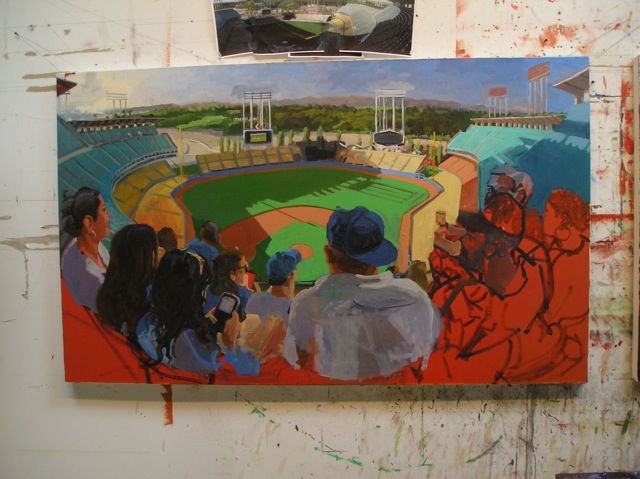
But I was struggling with the painting as a whole. Some things were working, but others, the field, the landscape, the overall composition, just didn’t come anywhere near to the feeling I remembered being there. I put it aside, hoping a fresh view, as it often does, would re-inspire me.
It was almost a year later before I had a chance to get back to it. Large wholesale changes were in order.
[[wysiwyg_imageupload:168:]]The whole thing was too central, right down the middle. The figures all looked too big, and almost all of them were facing away. In my original photos was a shot of an angelic usher and a guy in a white tee shirt heading down the steps, the light on his back a blinding white.
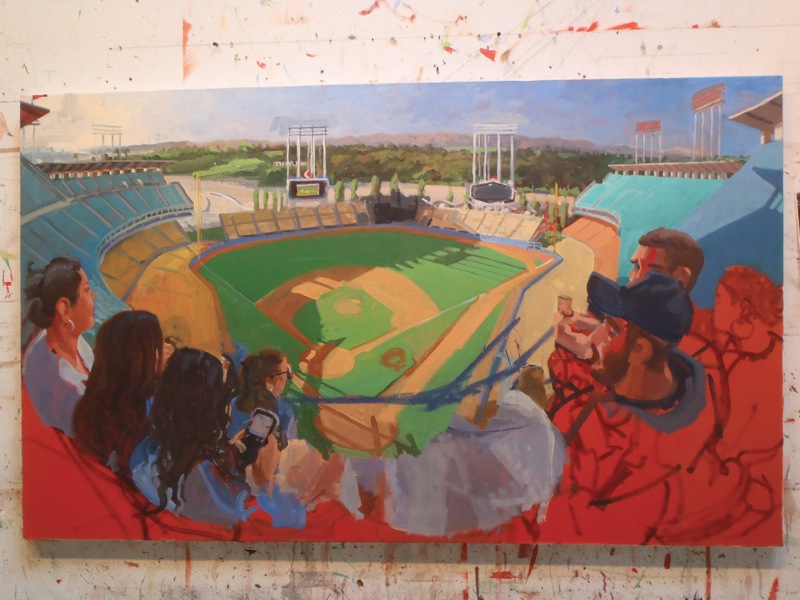
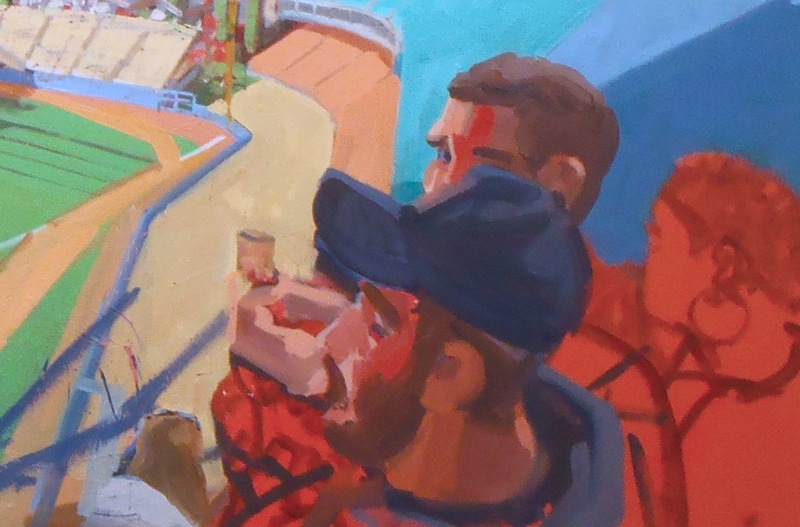
I sketched out a new composition using them, the usher on the far left, standing guard almost, and the tee shirt guy descending the stairs, down into the seating bowl,
[[wysiwyg_imageupload:177:]]From there I began again, reforming the figures, and repositioning the field. We were now up the third base line right on the edge of a row with the light of one of the portals streaming across and uniting the whole composition. The steps and railing led your eye down to the field. The whole thing wasn’t just front/back -fans/field. There was much more movement across and around the whole composition. The painting was much more of a journey to an idyllic oasis.
x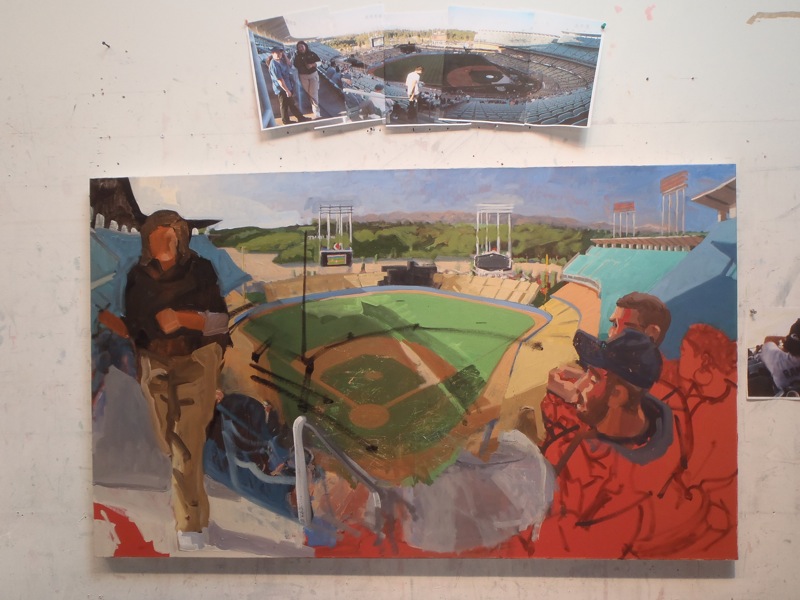
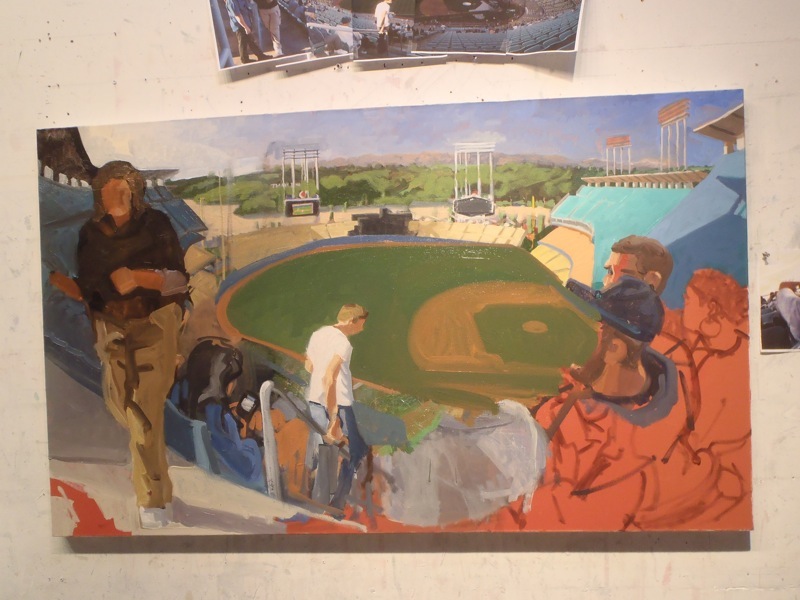
I sketched out a new composition using them, the usher on the far left, standing guard almost, and the tee shirt guy descending the stairs, down into the seating bowl,
[[wysiwyg_imageupload:177:]]From there I began again, reforming the figures, and repositioning the field. We were now up the third base line right on the edge of a row with the light of one of the portals streaming across and uniting the whole composition. The steps and railing led your eye down to the field. The whole thing wasn’t just front/back -fans/field. There was much more movement across and around the whole composition. The painting was much more of a journey to an idyllic oasis.
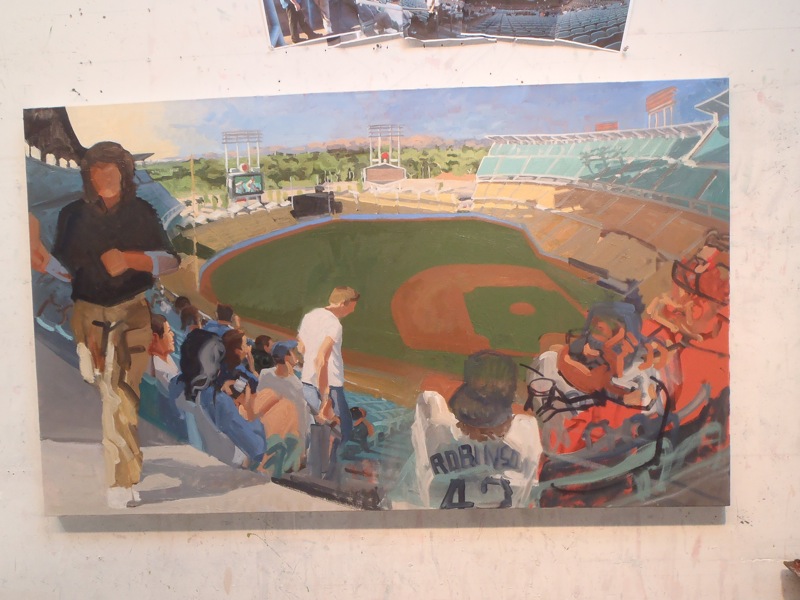
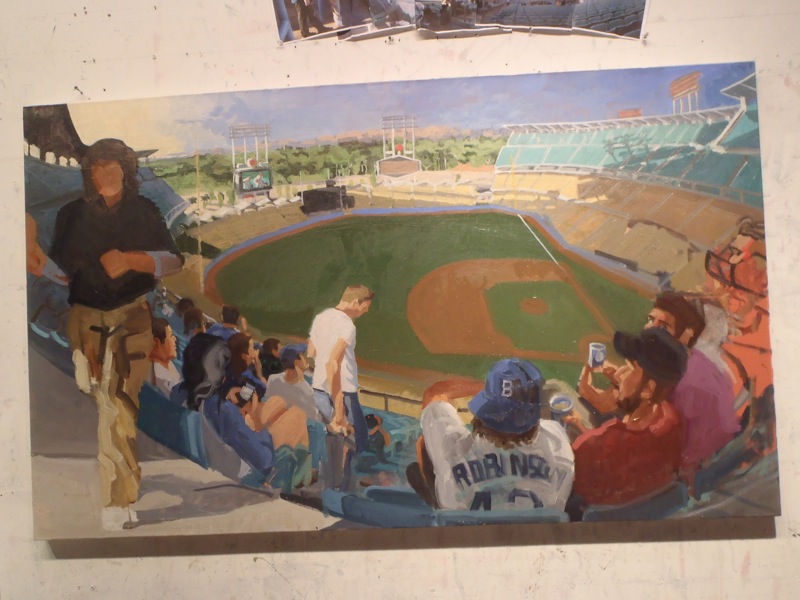
The last major compositional move was to flip a girl that had been on the far left, was now covered by the usher, and put her in the open space on the far right. Her hoop earring is a great shape, a splash of gold light and her vee neck shirt gives a bit of sexiness amidst the fellas.
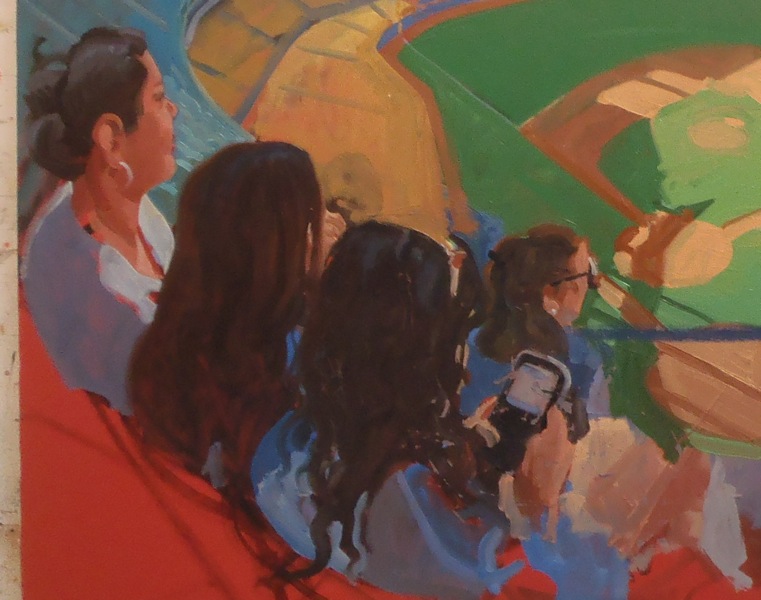
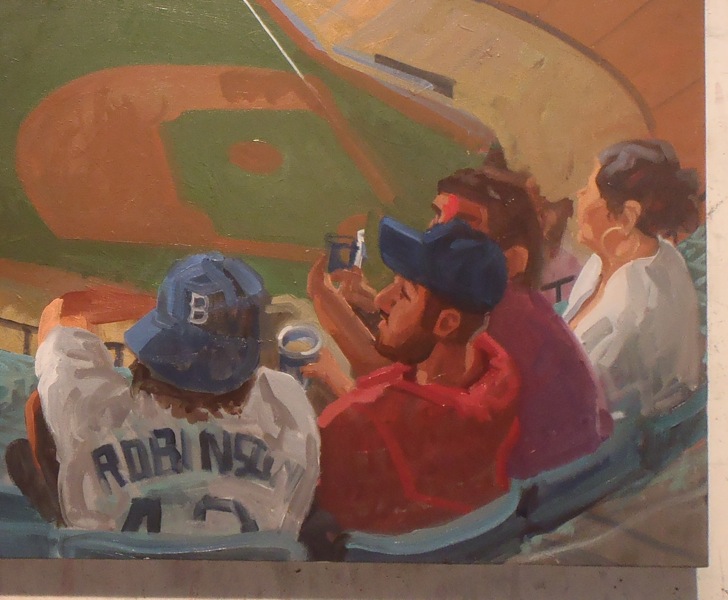
There were just a couple days before the painting had to be delivered, not much time to develop and refine. In retrospect that could have been a blessing. More activity on the field might have been distracting. I did put a member of the grounds crew raking the mound and several black clad security guards surrounding the field, hopefully giving a slight, even subliminal sense of it being a sanctuary.
“Dreamland, Dodger Stadium”, oil on canvas, 36″ x 60″, 2013
A huge thank you to Ry Cooder and his album “Chavez Ravine”. It is a musical masterpiece and historical treasure. The music and album booklit were the inspiration for much of the blog post. On a side note, some beautiful live music was coming from the home I parked near in the reminants of Chavez Ravine. I fantasize it was Ry and his son Jaochim jamming as I sketched the hills and homes of the neighborhood before heading over to the ball park for the game.
Thank you Ry
